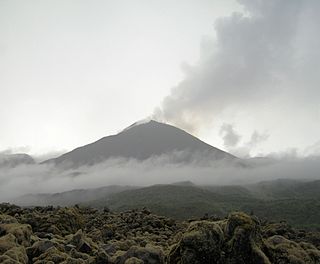Related Research Articles

An active volcano is a volcano that has erupted during the Holocene, is currently erupting, or has the potential to erupt in the future. A volcano that is not currently erupting but could erupt in the future is known as a dormant volcano. Volcanoes that will not erupt again are known as extinct volcanoes.
The Decade Volcanoes are 16 volcanoes identified by the International Association of Volcanology and Chemistry of the Earth's Interior (IAVCEI) as being worthy of particular study in light of their history of large, destructive eruptions and proximity to densely populated areas. The Decade Volcanoes project encourages studies and public-awareness activities at these volcanoes, with the aim of achieving a better understanding of the volcanoes and the dangers they present, and thus being able to reduce the severity of natural disasters.

Reventador is an active stratovolcano which lies in the eastern Andes of Ecuador. It lies in a remote area of the national park of the same name, which is Spanish for "exploder". Since 1541, it has erupted over 25 times, although its isolated location means that many of its eruptions have gone unreported.

Lava lakes are large volumes of molten lava, usually basaltic, contained in a volcanic vent, crater, or broad depression. The term is used to describe both lava lakes that are wholly or partly molten and those that are solidified.

Apoyeque is a pyroclastic shield, located in the Chiltepe Peninsula Natural Reserve in Nicaragua. It has a 2.8-km wide, 400-m-deep, lake-filled caldera.

The Antillanca Group is a volcanic group of scoria cones, maars and small stratovolcanoes, in Chile. Casablanca stratovolcano is the tallest volcano of the group, which shelters the Antillanca ski resort on its west flank. Aguas Calientes and Puyehue Hot springs also form part of this volcanic group. The complex encompasses 380 km2 and to the west is bordered by the lakes Puyehue and Rupanco.

Akan Volcanic Complex is a volcanic group of volcanoes that grew out of the Akan caldera. It is located within Akan National Park, about 50 km Northwest of Kushiro in eastern Hokkaidō, Japan.

The Smithsonian Institution's Global Volcanism Program (GVP) documents Earth's volcanoes and their eruptive history during the Quaternary Period of Earth's geologic history, with particular emphasis on volcanic activity during the Holocene Epoch. The mission of the GVP is to document, understand, and disseminate information about global volcanic activity.

The volcanic history of the Northern Cordilleran Volcanic Province presents a record of volcanic activity in northwestern British Columbia, central Yukon and the U.S. state of easternmost Alaska. The volcanic activity lies in the northern part of the Western Cordillera of the Pacific Northwest region of North America. Extensional cracking of the North American Plate in this part of North America has existed for millions of years. Continuation of this continental rifting has fed scores of volcanoes throughout the Northern Cordilleran Volcanic Province over at least the past 20 million years and occasionally continued into geologically recent times.
The Salal Glacier volcanic complex is a complex volcano in the Pacific Ranges of the Coast Mountains in southwestern British Columbia, Canada, located near the upper Bridge River. It is part of a volcanic group called the Bridge River Cones which in turn is part of the Garibaldi Volcanic Belt of the Canadian Cascade Arc.
References
- ↑ "Olkoviy Volcanic Group". Global Volcanism Program . Smithsonian Institution . Retrieved 2021-06-22.
- ↑ "Etorofu-Yakeyama [Grozny Group]". Global Volcanism Program . Smithsonian Institution . Retrieved 2021-06-22.
- ↑ "Kunlun Volcanic Group". Global Volcanism Program . Smithsonian Institution . Retrieved 2021-06-22.